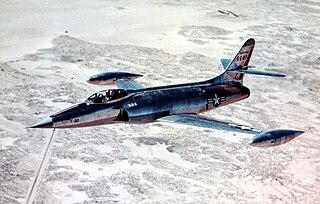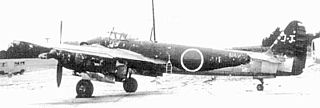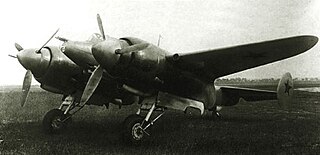
The Focke-Wulf Ta 154 Moskito was a fast twin-engined German night fighter aircraft designed by Kurt Tank and produced by Focke-Wulf during late World War II. Only a few were produced, proving to have less impressive performance than the prototypes.

The Dornier Do 335Pfeil (Arrow) is a heavy fighter built by Dornier for Germany during World War II. The Pfeil's performance was predicted to be better than other twin-engine designs due to its unusual push-pull configuration and the lower aerodynamic drag of the in-line alignment of the two engines. It was Nazi Germany's fastest piston-engined aircraft of World War II. The Luftwaffe was desperate to get the design into operational use, but delays in engine deliveries meant that only a handful were delivered before the war ended.

The Focke-Wulf Fw 187 Falke ("Falcon") was a German aircraft designed in 1935. It was conceived by Kurt Tank as a twin-engine, high-performance fighter, but the Luftwaffe saw no role for the design, perceiving it as intermediate between the Messerschmitt Bf 109 and Bf 110. Later prototypes were adapted to two-seats to compete with the Bf 110 in the heavy fighter (Zerstörer) role, but only nine aircraft were built in total.

The Grumman F7F Tigercat is a heavy fighter aircraft that served with the United States Navy (USN) and United States Marine Corps (USMC) from late in World War II until 1954. It was the first twin-engine fighter to be deployed by the USN. While the Tigercat was delivered too late to see combat in World War II, it did serve in reconnaissance roles. The Tigercat primarily saw action as a night fighter and attack aircraft during the Korean War.

The Grumman F8F Bearcat is an American single-engined, carrier-based fighter aircraft introduced in late World War II. It served during the mid-20th century in the United States Navy, the United States Marine Corps, and the air forces of other nations. It was Grumman Aircraft's last piston-engined fighter aircraft. Adapted versions of the Bearcat have broken speed records for piston-engined aircraft. Today, the Bearcat is popular among warbird owners and air racers.

The Douglas XB-42 Mixmaster is an experimental American bomber aircraft, designed for a high top speed. The unconventional approach was to mount the two engines within the fuselage driving a pair of contra-rotating propellers mounted at the tail in a pusher configuration, leaving the wing and fuselage clean and free of drag-inducing protrusions.

The Lockheed XF-90 was built in response to a United States Air Force requirement for a long-range penetration fighter and bomber escort. The same requirement produced the McDonnell XF-88 Voodoo. Lockheed received a contract for two prototype XP-90s. The design was developed by Willis Hawkins and the Skunk Works team under Kelly Johnson. Two prototypes were built. Developmental and political difficulties delayed the first flight until 3 June 1949, with Chief Test Pilot Tony LeVier at the controls. Embodying the experience gained in developing the P-80 Shooting Star, the XF-90 shared some design traits with the older Lockheed fighter, albeit with swept-wings; however, this latter design choice could not sufficiently make up for the project’s underpowered engines, and the XF-90 never entered production.

The Nakajima J5N was an abandoned Japanese prototype fighter aircraft of the World War II era. J5N was developed as twin-engine interceptor for countering attacks by Boeing B-29 Superfortress.

The Grumman F3F is a biplane fighter aircraft produced by the Grumman aircraft for the United States Navy during the mid-1930s. Designed as an improvement on the F2F, it entered service in 1936 as the last biplane to be delivered to any American military air arm. It was retired from front line squadrons at the end of 1941 before it could serve in World War II, and replaced by the Brewster F2A Buffalo. The F3F, which inherited the Leroy Grumman-designed retractable main landing gear configuration first used on the Grumman FF, served as the basis for a biplane design ultimately developed into the much more successful F4F Wildcat that succeeded the subpar Buffalo.

The Bell XFL Airabonita was an American experimental carrier-based interceptor aircraft developed for the United States Navy by Bell Aircraft Corporation of Buffalo, New York. It was similar to and a parallel development of the U.S. Army Air Corps’ land-based P-39 Airacobra, differing mainly in the use of a tailwheel undercarriage in place of the P-39's tricycle gear. Only one prototype was built.

The Grumman XP-50 was a land-based development of the shipboard XF5F-1 Skyrocket fighter, entered into a United States Army Air Corps (USAAC) contest for a twin-engine heavy interceptor aircraft. The USAAC placed an order for a prototype on 25 November 1939, designating it XP-50, but it lost the competition to the Lockheed XP-49.

The McDonnell XP-67 "Bat" or "Moonbat" was a prototype for a twin-engine, long-range, single-seat interceptor aircraft for the United States Army Air Forces. Although the design was conceptually advanced, it was beset by numerous problems and never approached its anticipated level of performance. The project was cancelled after the sole completed prototype was destroyed by an engine fire.

The Grumman XTSF was a proposed twin-engine torpedo scout aircraft, designed by Grumman for the United States Navy towards the end of World War II. Based on the design of the Grumman F7F Tigercat fighter, but enlarged and with the addition of a bomb bay, the XTSF was deemed too large for carrier operations, and the project was cancelled before any aircraft were built. Instead, the Navy chose to order the single-engine XTB3F, which became the successful AF Guardian.
The Kawasaki Ki-102 or Type 4 Attack Plane was a Japanese warplane of World War II. It was a twin-engine, two-seat, long-range heavy fighter developed to replace the Ki-45 Toryu. Three versions were planned: the Ki-102 Kō day fighter, Ki-102 Otsu ground-attack and Ki-102 Hei night fighter. This aircraft's Allied reporting name was "Randy".

The Gregor FDB-1 was a Canadian biplane fighter, designed in 1938 by Michael Gregor and manufactured by Canadian Car and Foundry. Despite having some advanced design features such as flush rivetted all-metal construction and a retractable undercarriage, the final generation of biplane fighters was being supplanted by monoplanes and the Gregor FDB-1 was obsolete before it flew. Despite the Royal Canadian Air Force's desperation for modern fighters, the sole example remained unsold and was eventually lost in a fire in 1945. The Gregor FDB-1's model designation stood for Fighter Dive Bomber indicating its intended roles.

The Gloster F.9/37, also known as the Gloster G.39, was a British twin-engined design from the Gloster Aircraft Company for a cannon-armed heavy fighter to serve with the Royal Air Force, planned before the Second World War. The F.9/37 was rejected in favour of other designs.

The Savoia-Marchetti SM.91 was a two-seat, twin-engined, Italian heavy fighter prototype, designed to compete in a 1942 revision to a long-range fighter-bomber contract offered by the Regia Aeronautica to Italian aircraft companies in 1938. The original 1938 specification yielded the Savoia-Marchetti SM.88, which the SM.91 was largely based on.

The Mitsubishi Ki-83 (キ83) was a Japanese experimental long range heavy fighter designed near the end of World War II. It did not reach production status.

The Tairov Ta-3 was a twin-engined single-seat heavy fighter designed and produced in the Ukrainian SSR in the Soviet Union from 1939. The Ta-3 was envisioned to serve primarily as an escort fighter. Competing contemporaneous designs in the USSR included the Grushin Gr-1, Mikoyan-Gurevich DIS and Polikarpov TIS.

The Yakovlev Yak-140 was a Soviet prototype lightweight supersonic fighter developed during the 1950s. The prototype was completed in 1954, but it was denied authorization to enter flight testing and the program was cancelled in 1956.




















